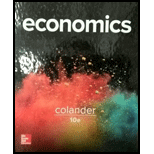
(a)
Determine the percentage of tax borne by a demander and supplier if Es is 1.2 and ED is 0.3.
(a)
Explanation of Solution
If the
Thus, the percentage of tax borne by a demander is 80.
Thus, the percentage of tax borne by a supplier is 20.
(b)
Determine the percentage of tax borne by a demander and a supplier if Es is 2 an ED is 3.
(b)
Explanation of Solution
If the elasticity of
Thus, the percentage of tax borne by a demander is 40.
Thus, the percentage of tax borne by a supplier is 60.
(c)
Determine the percentage of tax borne by a demander and supplier if Es is 1 and ED is 0.5.
(c)
Explanation of Solution
If the elasticity of demand is 0.5 and elasticity of supply is 1, then the percentage of tax borne by a demander and supplier can be calculated as follows:
Thus, the percentage of tax borne by a demander is 66.67.
Thus, the percentage of tax borne by a supplier is 33.33.
(c)
Determine the percentage of tax borne by a demander and supplier if Es is 1 an ED is 0.5.
(c)
Explanation of Solution
If the elasticity of demand is 0.5 and elasticity of supply is 1, then the percentage of tax borne by a demander and supplier can be calculated as follows:
Thus, the percentage of tax borne by a demander is 66.67.
Thus, the percentage of tax borne by a supplier is 33.33.
(d)
Determine the percentage of tax borne by a demander and a supplier if Es is 0.5 and ED is 0.5.
(d)
Explanation of Solution
If the elasticity of demand is 0.5 and elasticity of supply is 0.5, then the percentage of tax borne by a demander and a supplier can be calculated as follows:
Thus, the percentage of tax borne by a demander is 50.
Thus, the percentage of tax borne by a supplier is 50.
(e)
Explain the finding regarding relative elasticity and tax burden.
(e)
Explanation of Solution
Here, the consumers with relatively more elastic demand curve will bear a smaller percentage of the tax. Thus, if the elasticity of demand curves and supply curves eas equal, then the consumer and producer share the tax burden evenly.
Want to see more full solutions like this?
Chapter 7 Solutions
Economics
- 17. Given that C=$700+0.8Y, I=$300, G=$600, what is Y if Y=C+I+G?arrow_forwardUse the Feynman technique throughout. Assume that you’re explaining the answer to someone who doesn’t know the topic at all. Write explanation in paragraphs and if you use currency use USD currency: 10. What is the mechanism or process that allows the expenditure multiplier to “work” in theKeynesian Cross Model? Explain and show both mathematically and graphically. What isthe underpinning assumption for the process to transpire?arrow_forwardUse the Feynman technique throughout. Assume that you’reexplaining the answer to someone who doesn’t know the topic at all. Write it all in paragraphs: 2. Give an overview of the equation of exchange (EoE) as used by Classical Theory. Now,carefully explain each variable in the EoE. What is meant by the “quantity theory of money”and how is it different from or the same as the equation of exchange?arrow_forward
- Zbsbwhjw8272:shbwhahwh Zbsbwhjw8272:shbwhahwh Zbsbwhjw8272:shbwhahwhZbsbwhjw8272:shbwhahwhZbsbwhjw8272:shbwhahwharrow_forwardUse the Feynman technique throughout. Assume that you’re explaining the answer to someone who doesn’t know the topic at all:arrow_forwardUse the Feynman technique throughout. Assume that you’reexplaining the answer to someone who doesn’t know the topic at all: 4. Draw a Keynesian AD curve in P – Y space and list the shift factors that will shift theKeynesian AD curve upward and to the right. Draw a separate Classical AD curve in P – Yspace and list the shift factors that will shift the Classical AD curve upward and to the right.arrow_forward
- Use the Feynman technique throughout. Assume that you’re explaining the answer to someone who doesn’t know the topic at all: 10. What is the mechanism or process that allows the expenditure multiplier to “work” in theKeynesian Cross Model? Explain and show both mathematically and graphically. What isthe underpinning assumption for the process to transpire?arrow_forwardUse the Feynman technique throughout. Assume that you’re explaining the answer to someone who doesn’t know the topic at all: 15. How is the Keynesian expenditure multiplier implicit in the Keynesian version of the AD/ASmodel? Explain and show mathematically. (note: this is a tough one)arrow_forwardUse the Feynman technique throughout. Assume that you’re explaining the answer to someone who doesn’t know the topic at all: 13. What would happen to the net exports function in Europe and the US respectively if thedemand for dollars rises worldwide? Explain why.arrow_forward

 Principles of Economics (12th Edition)EconomicsISBN:9780134078779Author:Karl E. Case, Ray C. Fair, Sharon E. OsterPublisher:PEARSON
Principles of Economics (12th Edition)EconomicsISBN:9780134078779Author:Karl E. Case, Ray C. Fair, Sharon E. OsterPublisher:PEARSON Engineering Economy (17th Edition)EconomicsISBN:9780134870069Author:William G. Sullivan, Elin M. Wicks, C. Patrick KoellingPublisher:PEARSON
Engineering Economy (17th Edition)EconomicsISBN:9780134870069Author:William G. Sullivan, Elin M. Wicks, C. Patrick KoellingPublisher:PEARSON Principles of Economics (MindTap Course List)EconomicsISBN:9781305585126Author:N. Gregory MankiwPublisher:Cengage Learning
Principles of Economics (MindTap Course List)EconomicsISBN:9781305585126Author:N. Gregory MankiwPublisher:Cengage Learning Managerial Economics: A Problem Solving ApproachEconomicsISBN:9781337106665Author:Luke M. Froeb, Brian T. McCann, Michael R. Ward, Mike ShorPublisher:Cengage Learning
Managerial Economics: A Problem Solving ApproachEconomicsISBN:9781337106665Author:Luke M. Froeb, Brian T. McCann, Michael R. Ward, Mike ShorPublisher:Cengage Learning Managerial Economics & Business Strategy (Mcgraw-...EconomicsISBN:9781259290619Author:Michael Baye, Jeff PrincePublisher:McGraw-Hill Education
Managerial Economics & Business Strategy (Mcgraw-...EconomicsISBN:9781259290619Author:Michael Baye, Jeff PrincePublisher:McGraw-Hill Education





